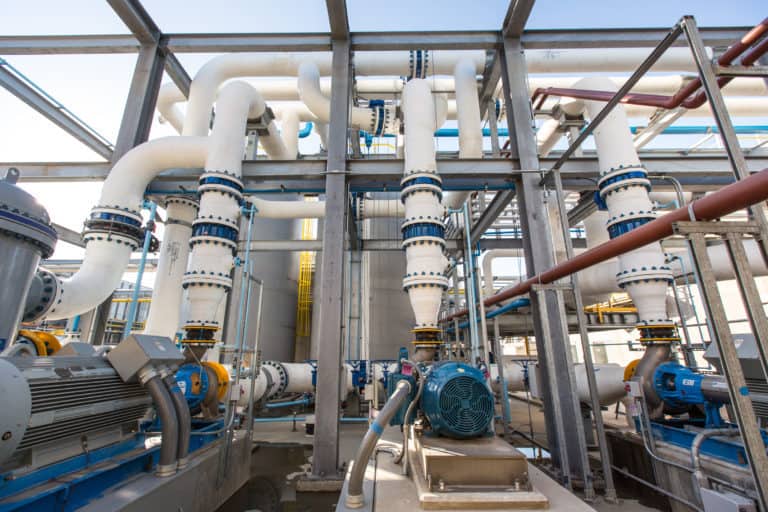
In the traditional hydrosphere, freshwater rivers flow from their headwaters into the ocean, releasing potential gravitational energy along the way. In seawater desalination, the process is reversed. Producers pull saltwater from the ocean, invest energy, and produce freshwater, which is then pumped uphill for use in built environments. As of 2010, nearly 17,000 desalination plants provided approximately 68 million cubic meters (m³) (18,000 million gallons) per day of freshwater.1Global Water Intelligence, Desalination Markets 2010: Global Forecast and Analysis (Oxford: Global Water Intelligence, 2010). Economists project the capacity to keep growing. While thermal desalination (using heat) represented about 25% of the installed capacity by 2010, this method represented a shrinking share of new installations, as builders sought the less energy-intensive reverse osmosis membrane-based system. Even the lower-energy approach consumes an order of magnitude more energy than traditional freshwater treatment and distribution. In addition to energy intensity, desalination infrastructure requires massive capital investments. In 2010, the global market approached $6 billion, and analysts predict the market to reach $18 billion in 2016.
Desalination growth is centered in energy-rich, water-poor regions of the world, such as the Middle East, northern Africa, and Australia. After a severe drought that lasted several years, water-strapped Israel turned to the sea for its freshwater, rapidly building a handful of desalination plants to produce about 200 billion gallons (760 million m³) of freshwater annually by desalinating water from the Mediterranean.2Isabel Kershner, “Aided by the Sea, Israel Overcomes and Old Foe: Drought,” New York Times, May 29, 2015. Booming industrial activity in China is straining water supplies that serve the world’s largest population and is spurring rapid growth in desalination there. Recently, desalination capacity is also growing in locations such as London and the United States, where the abundance of water is very different than in the arid regions of the world.
While the cumulative installed desalination capacity continues to increase, the rate at which new projects come online has slowed from 2010 to 2016.
Despite relative water wealth, the United States is the world’s second-largest market for desalination, trailing only Saudi Arabia.3Global Water Intelligence, Desalination Markets 2010: Global Forecast and Analysis (Oxford: Global Water Intelligence, 2010). Unequal distribution of water resources, high per capita water consumption, and readily accessible capital for investments spur the development of desalination in the United States. Companies and cities in California, Texas, and Florida are considering projects for seawater reverse osmosis. Inland Texas, Arizona, and New Mexico are also home to brackish water projects.
When necessary, water solutions can combine desalination and long-haul transfer requiring even larger investments of energy.4A. S. Stillwell, C. W. King, and M. E. Webber, “Desalination and Long-Haul Water Transfer as a Water Supply for Dallas, Texas: A Case Study of the Energy-Water Nexus in Texas,” Texas Water Journal 1 (2010), 33-41. Gravity pulls water to the sea naturally. Coastal waters at sea level require pumping water uphill to cities. For example, a planned project to move water from a coastal facility along the Gulf of Mexico to San Antonio, Texas, requires piping water 150 miles (240 kilometers) inland, increasing in elevation nearly 775 feet (235 meters). Freshwater scarcity and energy abundance in places such as the Middle East or Libya overcome the environmental and financial drawbacks of desalination. However, in places such as the United Kingdom or the United States will benefit from other cost-effective options such as water conservation, gray water capture, and water reuse.

Image Credits: Fat Jackey/Shutterstock.com; Courtesy/Carlsbad Desalination Plant.
Update your browser to view this website correctly.Update my browser now